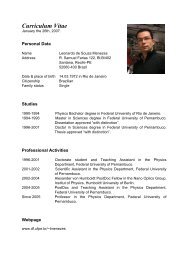Download Abstracts Book - DF-UFPE Pessoal
Download Abstracts Book - DF-UFPE Pessoal
Download Abstracts Book - DF-UFPE Pessoal
Create successful ePaper yourself
Turn your PDF publications into a flip-book with our unique Google optimized e-Paper software.
15<br />
MINICOURSES<br />
Mössbauer spectroscopy for materials science: The aging effect in<br />
superconductor CaLaBa{Cu 1−x Fe x } 3 O 7−δ with 0≤ x ≤0.07.<br />
Angel Bustamante 1<br />
1 Laboratorio de cerámicos y nanomateriales, Universidad Nacional Mayor de San Marcos,<br />
Lima, Peru.<br />
The Mössbauer effect is the emission and absorption resonant recoilless nuclear gamma<br />
rays and corresponds to the zero-phonon transition. The term recoilless is interpreted as<br />
the crystal as a whole suffers a recoil almost negligible. Mössbauer effect is likely to<br />
happen and corresponds to the factor f which depends on the temperature. To this effect<br />
and using the Doppler velocity hyperfine interactions detected as the isomer shift (IS)<br />
which is due to the finite size of the nucleus and the term expansion monopolar<br />
electrostatic interaction energy between nucleus, total electric charge Ze distributed<br />
over the nuclear volume density N (r) at point r and an electrical potential V(r) due to<br />
the loads on the environment. This interaction also displaces energy levels without<br />
altering the transition energies of both the radioactive source which emits the gamma<br />
ray absorber and provided in the oxidation state and coordination atom studied. The<br />
second term in the expansion is the electric dipole between the electric dipole moment<br />
and the electric field in the center of the core. This term is zero because the core does<br />
not have electric dipole moment. The third term corresponds to the interaction of the<br />
nuclear quadrupole moment with the electric field gradient (EFG) produced by an<br />
asymmetric distribution around the nucleus charges (electrons, ions, dipoles, etc.) and is<br />
the cause of the degeneration partially unfold 2I + 1 nuclear levels and for the case of<br />
Fe 57 with fundamental level, I g =1/2, that unfolds, and excited, with I e =3/2, is split into<br />
two sublevels with m 3/2 = 3/2 and 1/2, two lines shown in the Mössbauer spectrum<br />
whose separation is called quadrupole splitting QS or E Q , and provides information on<br />
the oxidation state and coordination number of the distortion of the crystal lattice.<br />
Nuclei with nuclear magnetic moment can interact with a magnetic field H which can<br />
be a field external or internal fields o hyperfine fields H hf that can be produced by the<br />
spin and the unpaired electrons (dipole field), the angular moment produced by the<br />
orbital electrons. Electrons "s" and those who are not full layers contribute to this<br />
component (orbital field) and produced by electrons "s" that penetrate the nucleus<br />
(Fermi contact field). The magnetic interaction completely breaks the degeneracy of the<br />
nuclear spin levels I0 and unfolded each level 2I+1 equally spaced sublevels. The<br />
allowed transitions between these sublevels are governed by the selection rules<br />
m I =0,1 andI =1. The experimental arrangement for the case of iron considered a<br />
radioactive Co 57 source in a matrix of Rhodium which emits 14.4 Kev gamma ray, an<br />
absorber containing iron, a multichannel analyzer 512 or1024 channels and a software<br />
for fitting spectra. In this talk, we will present an introduction to Mössbauer<br />
spectroscopy an the long-term aging effect caused by Fe atoms in the superconductor<br />
CaLaBa{Cu 1−x Fe x } 3 O 7−δ with 0 ≤ x ≤ 0.07. XRD confirms that this system has a<br />
YBCO-like structure. The critical temperature (Tc) is strongly affected by aging and<br />
depends on the amount of Fe in the structure. Room temperature Mössbauer<br />
spectroscopy reveals the presence of the typical species A, B–B´, C and new species<br />
E´and F. Interestingly; A, which corresponds to the Fe 3+ atom located in the Cu(1) of<br />
the chains with spin S z = 3/2, shows a drastic reduction which means migration to the<br />
species B, B´ and C. Species B and B´correspond to the Fe 3+ in the Cu(2) site forming<br />
planar quasi-octahedral and planar square pyramidal, while the C specie is a square<br />
pyramidal with O(5) respectively (spin S z = 3/2 in all these cases). Aging causes loss of<br />
superconductivity in the samples with 5 and 7% of iron content.






